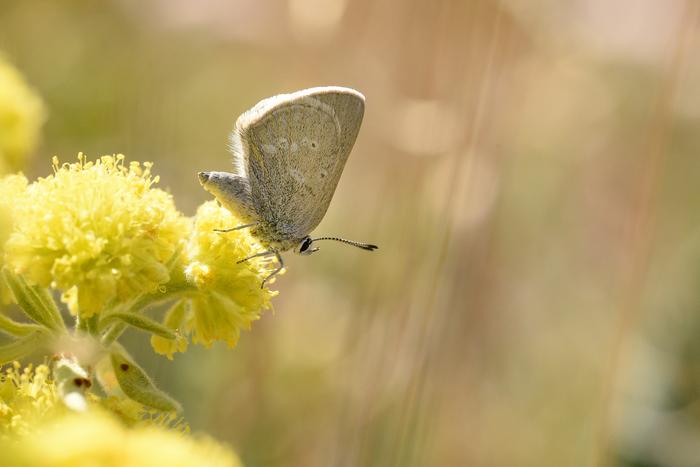Deep within the rugged terrain of Canada’s Rocky Mountains, a breakthrough discovery has emerged that reshapes our understanding of butterfly diversity and conservation biology. Scientists have identified a previously unrecognized butterfly species, now named Satyrium curiosolus, the Curiously Isolated Hairstreak. For decades, this diminutive insect was mistaken for its close relative, the Half-moon Hairstreak (Satyrium semiluna), but an international team of researchers has now confirmed through cutting-edge genomic and ecological studies that S. curiosolus is a unique lineage with a rich evolutionary history far divergent from any known counterpart.
This revelation came as a result of whole-genome sequencing combined with meticulous ecological observations. The team’s genomic analysis revealed strikingly low genetic diversity within the S. curiosolus population, coupled with unusually high levels of historical inbreeding. These findings indicate that this butterfly lineage has remained completely isolated for up to 40,000 years, a remarkable example of long-term evolutionary separation. The degree of genetic differentiation suggests that S. curiosolus is more than a mere subspecies—it represents an independent evolutionary trajectory that warrants its classification as a new species.
Situated exclusively on the Blakiston Fan in Waterton Lakes National Park, Alberta, Satyrium curiosolus occupies a habitat completely unlike any other related populations. While S. semiluna thrives in sagebrush steppes across British Columbia and Montana, S. curiosolus calls a distinct prairie-grassland ecosystem its home. This unique environment exposes it to different plant and ant species, reflecting an ecological niche that likely played a pivotal role in steering its divergence. Most notably, the larvae of S. curiosolus rely entirely on the silvery lupine (Lupinus argenteus) for development—an association not observed in S. semiluna populations.
The butterfly’s ecological interactions extend beyond its host plant. Researchers uncovered a mutualistic relationship between S. curiosolus larvae and a specific ant species, Lasius ponderosae. This symbiosis, absent in related hairstreaks, is vital for the butterfly’s survival. The caterpillars secrete a sugary substance called honeydew which feeds the ants, while the ants provide protection from predators and parasites. Caterpillars also seek refuge within ant galleries when temperatures soar or when threatened, and adults strategically lay eggs near ant colony entrances tucked within silvery lupine patches. This intricate network of interactions underscores the specialized ecological adaptations that have evolved in this isolated population.
Conservationists are thus tasked with devising novel approaches tailored specifically to S. curiosolus. The study suggests establishing additional populations to prevent extinction from localized disturbances, but such undertakings require detailed understanding of the species’ habitat requirements and ecological relationships. This discovery emphasizes the critical importance of habitat protection, particularly of the Blakiston Fan—a unique ecosystem that harbors this delicate butterfly and its associated biotic community.
This discovery also exemplifies how advances in genomic tools are revolutionizing biodiversity research. Julian Dupuis, an entomology professor involved in the study, highlights that traditional taxonomic methods relying solely on morphology often fail to reveal cryptic species diversity. Integrating genomic data with ecological observations allows scientists to unravel hidden evolutionary lineages and uncover biodiversity hotspots previously undetected. These insights are reshaping conservation priorities worldwide, directing attention to species and populations that may otherwise slip under the radar.
The collaborative nature of this research epitomizes modern conservation science. Partnerships between academic institutions, government agencies like Parks Canada, and conservation organizations including the Wilder Institute and Calgary Zoo enabled the amalgamation of diverse expertise—from genomics and field ecology to practical conservation management. Such interdisciplinary cooperation is essential to address the complex challenges posed by cryptic species and to develop actionable strategies to safeguard them amidst accelerating environmental changes.
Looking ahead, researchers stress the necessity of long-term monitoring to better understand S. curiosolus’ evolutionary dynamics and interactions within its ecosystem. Continuous field studies will help elucidate how factors like climate change impact this isolated population and inform adaptive management interventions. As Felix Sperling, curator at the University of Alberta’s Strickland Museum, points out, investigations that blend advanced genetic research with detailed ecological context provide powerful explanations for bizarre biological patterns—like the enigmatic presence of a species so isolated and specialized in the Rockies.
Ultimately, the story of Satyrium curiosolus is a compelling testament to nature’s hidden complexity and resilience. Discoveries such as this remind us that even small, inconspicuous creatures can harbor extraordinary evolutionary histories and bear profound scientific and conservation significance. As ecosystems face unprecedented challenges, recognizing and protecting cryptic biodiversity like the Curiously Isolated Hairstreak is crucial for preserving the intricate web of life on our planet.
Subject of Research: Genomic and ecological characterization of a newly recognized butterfly species, Satyrium curiosolus, endemic to the Canadian Rocky Mountains.
Article Title: Genomic and ecological divergence support recognition of a new species of endangered Satyrium butterfly (Lepidoptera, Lycaenidae)
News Publication Date: 17-Apr-2025
Web References: DOI link
References:
MacDonald ZG, Dupuis JR, Glasier JRN, Sissons R, Moehrenschlager A, Shaffer HB, Sperling FAH (2025) Genomic and ecological divergence support recognition of a new species of endangered Satyrium butterfly (Lepidoptera, Lycaenidae). ZooKeys 1234: 291-307.
Image Credits: MacDonald et al.
Tags: butterfly diversity and conservationCuriously Isolated Hairstreakecological observations in entomologyevolutionary biology of isolated speciesgenetic differentiation in Lepidopteragenomic analysis of butterflieshabitat specificity of butterflieshistorical inbreeding in butterfly populationslong-term evolutionary separation in insectsnew butterfly species discoverySatyrium curiosolusWaterton Lakes National Park biodiversity





